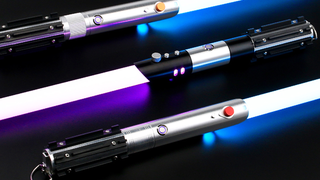The SpaceX CEO didn’t call out NASA’s expendable Space Launch System by name, though he might as well have. The 321-foot-tall (98-meter) SLS rocket, along with the Orion spacecraft, cost more than $50 billion to develop, and each launch of the Artemis rocket is expected to cost upwards of $4.1 billion—a price that inspector general Paul Martin has called “unsustainable.”
G/O Media may get a commission

*lightsaber hum*
SabersPro
For the Star Wars fan with everything.
These lightsabers powered by Neopixels, LED strips that run inside the blade shape that allow for adjustable colors, interactive sounds, and changing animation effects when dueling.
Advertisement
SLS has yet to leave the launch pad, and it’s already obsolete. China, it would appear, is not willing to march down that same path. Mind you, NASA made the decision to go with an expendable megarocket 12 years ago, in a decision guided heavily by politics and budgetary constraints. It wasn’t obvious to everyone back then that reusable rockets were feasible and safe. It certainly wasn’t obvious to NASA in 2010, but perhaps it should have been, given that the space agency is so celebrated for its innovations and accomplishments.
More on this story: Why Hydrogen Leaks Continue to Be a Major Headache for NASA Launches
China first proposed the idea of building an expendable super-heavy launch vehicle in 2018 for the purpose of transporting crews and cargo to Earth orbit and the Moon. Early mock-ups leaned toward NASA’s Space Launch System, which is poised to make its first launch on November 16.
Advertisement
The original plan was to have the Long March 9 deliver 100 metric tons to low Earth orbit, but China appears to be thinking bigger—both in terms of the rocket’s power and its recyclability. The upgraded plan, says SpaceNews, is for the Long March 9 to consist of three stages and be capable of lifting 150 metric tons to LEO. The rocket will stand 354 feet tall (108 meters) and weigh 4,180 metric tons.
“In recent years,” SpaceNews writes, senior CALT officials have “presented new concepts for the Long March 9, apparently in reaction to developments in reusability demonstrated by SpaceX.” Indeed, the company’s Falcon 9 is famous for its reusable first stage, but Starship—the heir apparent to the world’s most powerful rocket—will be fully reusable. No date has been set for the first launch of the fully stacked two-stage Starship, but it could happen later this year.
Advertisement
SpaceNews says the Chinese rocket is scheduled for its inaugural launch around 2030, but given that the design has not yet been finalized and that China has never performed a controlled vertical landing of a rocket, that seems wildly optimistic. According to the South China Morning Post, the Long March 9 will enter into operation around 2035, which sounds a bit more realistic. A recent hot fire test of the 500-metric-ton-thrust YF-130 engine, which will eventually power the Long March 9, suggests China is making progress.
As for SLS, only time well tell if the expendable expensive rocket has a future. Congress and American tax payers may find themselves fed up with the concept and opt for Elon’s solution instead.
Advertisement
More: Artemis 1: To Boldly Go Where Four RS-25 Engines Have Gone Many Times Before.